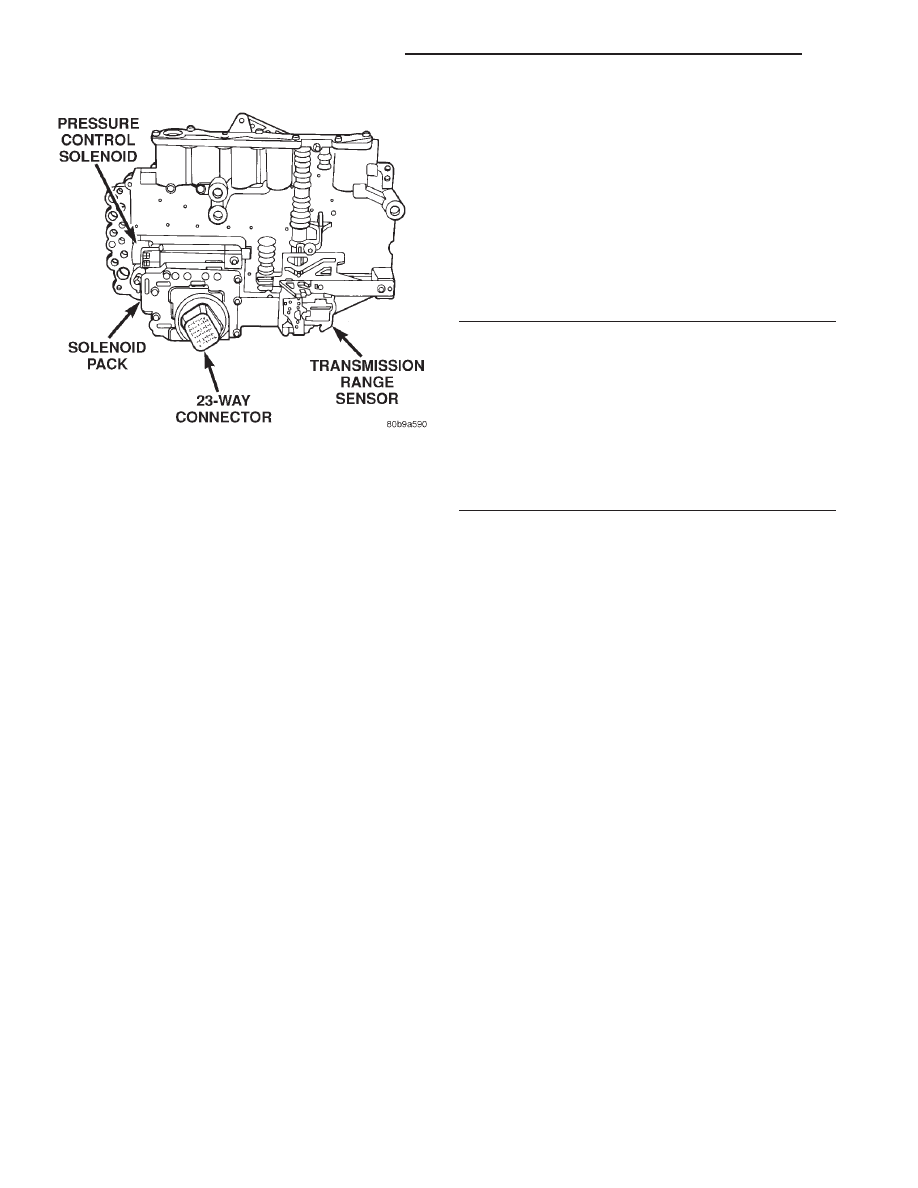Dodge Durango (DN). Manual - part 121

OPERATION
This battery voltage is necessary to retain adaptive
learn values in the TCM’s RAM (Random Access
Memory). When the battery (B+) is disconnected, this
memory is lost. When the battery (B+) is restored,
this memory loss is detected by the TCM and a Diag-
nostic Trouble Code (DTC) is set.
TRANSMISSION CONTROL RELAY
DESCRIPTION
The relay is supplied fused B+ voltage, energized
by the TCM, and is used to supply power to the sole-
noid pack when the transmission is in normal oper-
ating mode.
OPERATION
When the relay is “off”, no power is supplied to the
solenoid pack and the transmission is in “limp-in”
mode. After a controller reset, the TCM energizes the
relay. Prior to this, the TCM verifies that the con-
tacts are open by checking for no voltage at the
switched battery terminals. After this is verified, the
voltage at the solenoid pack pressure switches is
checked. After the relay is energized, the TCM mon-
itors the terminals to verify that the voltage is
greater than 3 volts.
PRESSURE SWITCHES
DESCRIPTION
The pressure switches are located inside the sole-
noid and pressure switch assembly and are only ser-
viced by replacing the assembly.
OPERATION
The TCM relies on five pressure switches to moni-
tor fluid pressure in the L/R, 2C, 4C, UD, and OD
hydraulic circuits. The primary purpose of these
switches is to help the TCM detect when clutch cir-
cuit hydraulic failures occur. The switches close at 23
psi and open at 11 psi, and simply indicate whether
or not pressure exists. The switches are continuously
monitored by the TCM for the correct states (open or
closed) in each gear as shown in the following chart:
A Diagnostic Trouble Code (DTC) will set if the
TCM senses any switch open or closed at the wrong
time in a given gear.
INPUT AND OUTPUT SPEED SENSORS
DESCRIPTION
The Input and Output Speed Sensors are two-wire
magnetic pickup devices that generate AC signals as
rotation occurs. They are mounted in the left side of
the transmission case and are considered primary
inputs to the Transmission Control Module (TCM).
OPERATION
The Input Speed Sensor provides information on
how fast the input shaft is rotating. As the teeth of
the input clutch hub pass by the sensor coil, an AC
voltage is generated and sent to the TCM. The TCM
interprets this information as input shaft rpm.
The Output Speed Sensor generates an AC signal
in a similar fashion, though its coil is excited by rota-
tion of the rear planetary carrier lugs. The TCM
interprets this information as output shaft rpm.
The TCM compares the input and output speed
signals to determine the following:
• Transmission gear ratio
• Speed ratio error detection
• CVI calculation
The TCM also compares the input speed signal and
the engine speed signal to determine the following:
Fig. 29 SOLENOID AND PRESSURE SWITCH
ASSEMBLY
GEAR
L/R
2C
4C
UD
OD
R
OP
OP
OP
OP
OP
P/N
CL
OP
OP
OP
OP
1ST
CL*
OP
OP
CL
OP
2ND
OP
CL
OP
CL
OP
2ND
PRIME
OP
OP
CL
CL
OP
D
OP
OP
OP
CL
CL
OD
OP
OP
CL
OP
CL
*L/R is closed if output speed is below 100 rpm in
Drive and Manual 2. L/R is open in Manual 1.
21 - 350
45RFE AUTOMATIC TRANSMISSION
DN
DESCRIPTION AND OPERATION (Continued)